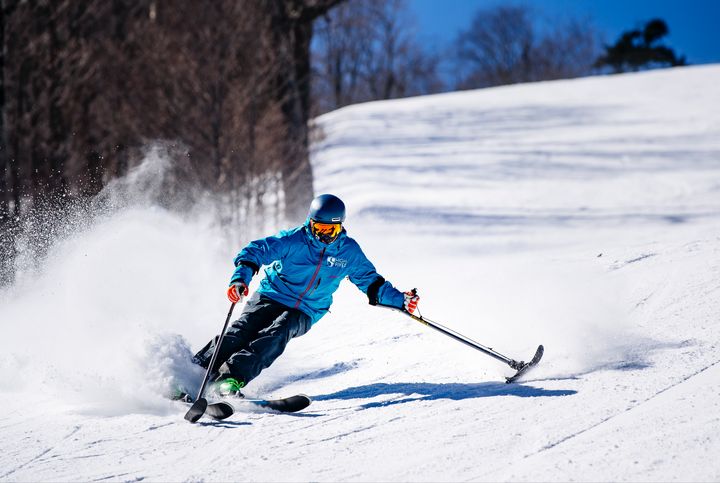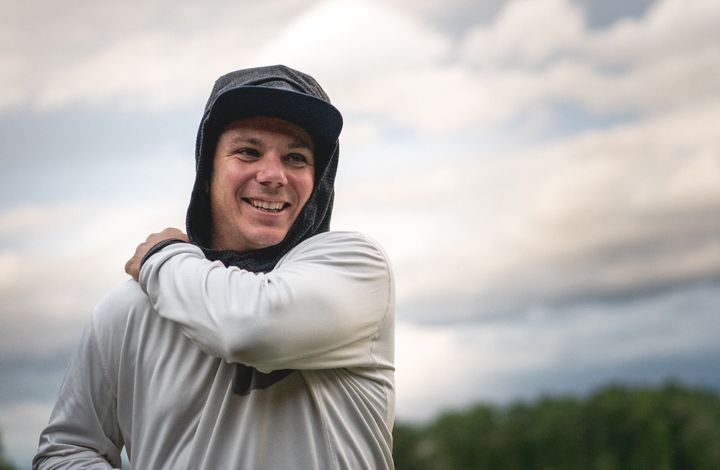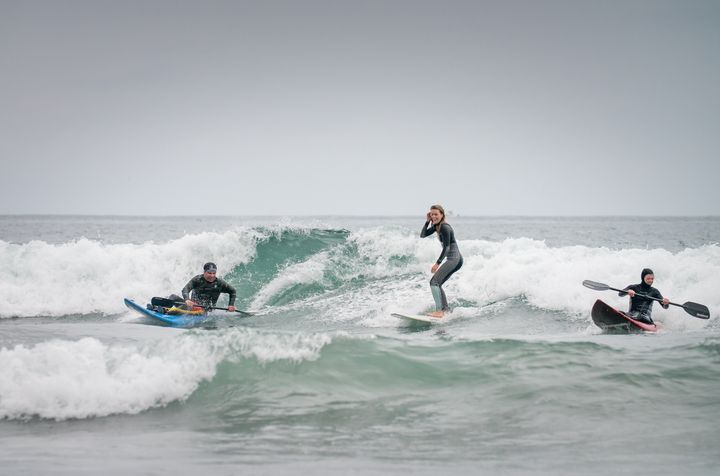
Roy Tuscany was living the life he’d always imagined. After graduating from the University of Vermont in 2004, Tuscany took a job as a freeride ski coach for the Sugar Bowl Academy near Lake Tahoe in California, while pursuing a career as a professional skier.
“It was a dream job,” he says. “I basically got to go skiing every day and got paid for it.”
In April 2006, his life took a drastic turn. Tuscany and other coaches visited California’s Mammoth Mountain Ski Area for an end-of-season retreat. Eager to try the terrain park, Tuscany got up early to take a couple laps. He hit a 100-foot jump going too fast, and overshot the jump by 30 feet. When he came down, Tuscany landed on his back, fracturing his T12 vertebra.
Lying in the snow, he didn’t know the extent of his injuries. “A friend skied up to me after I fell,” he recalls. “When I saw the look on her face, it was literally as if she just saw a puppy get hit by a car.” At the hospital, he learned that his lower body was paralyzed. Doctors told him he’d never walk again.
Today, he skis, bikes, and surfs using adaptive equipment created for people with paralysis. He credits his recovery to two years of grueling work in physical therapy, his strong faith, and an outpouring of support from the skiing communities of Lake Tahoe and Vermont.
Tuscany wanted to help other athletes injured in severe accidents. In January 2009, he started the High Fives Foundation, a nonprofit that provides injury prevention awareness as well as resources to people who have had spinal cord injuries, traumatic brain injuries, amputation or other injuries that affect mobility. The foundation raises funds that go toward athletes’ rehabilitation costs, including physical therapy, personal training and massage therapy; living and travel expenses; adaptive sports equipment, such as skis, bindings and other gear; race fees; and more.
The venture takes effort ― a lot of it.
“There’s nothing that bothers me more than when someone’s like, ‘Oh my god, you inspire me.’” he says. “I’d rather have someone tell me, ‘I appreciate your hard work.’”
To date, the foundation has helped over 200 athletes from 31 states get back into the game, and raised than $1.5 million in 2017 to fund its programs. It also hosts adaptive surf, ski and other sports camps throughout the year.
HuffPost spoke with Tuscany to learn more about his personal story and some of the most rewarding moments of his career.

How did you come up with the idea for the High Fives Foundation?
When I got hurt, Sugar Bowl Ski Academy set up a nonprofit called Roy’s Recovery Fund. In two years, I had $85,000 for my recovery. I sent thank-you notes, care packages and emails to everyone who had supported me, but I still felt empty. I was benefiting so much from these individuals, but I knew other people would fall into the same shoes that I did.
Two years after my recovery, I went back to skiing ― adaptively. That’s when I thought, “Alright, I’m ready to create this nonprofit to help others,” because paying it forward was so important to me.
How did you come up with the name?
The day after my surgery, my doctor came into my ICU room to give me a debrief on how the surgery went. He was like, “Yeah, we did this, this and this,” and I put my hand up for him to give me a high-five. He had no idea what I was talking about. I was like, “No, you can slap it. It’s totally good.” It was this weird breakdown of the typical doctor-patient communication. That was how I came up with the name of the organization.
What have been the challenges you’ve faced while creating the High Fives Foundation?
I created a niche nonprofit. One of the hard things out of the gate was showing people what we did and have people believing in it, because there was nothing else like it out there.
I didn’t go to school for nonprofit management or business management. I went to school for mechanical engineering and mathematics. To be 100 percent honest, I didn’t know what I was getting myself into.
We also have a safety education platform and a full-time gym that has a no-cost, no-question rehabilitation process. What we’ve created in nine years is absolutely nothing like what I originally set out for, but it’s everything that I always dreamed of.
You work with many people who are disabled, but you don’t use the word “disability” on your website. Why is that?
Our word is “athlete,” because the person was an athlete before, and they’re still an athlete after. We believe an athlete is anybody who has a goal. That goal can be anything. It just has to be a goal that has a timeline for success.

High Fives also created a safety awareness platform intended to help prevent injury in outdoor sports. Can you tell me about that?
Yeah, the BASICS platform, which is an acronym for Being Aware Safe In Critical Situations. It’s a safety education documentary that we produce every year and provide at no cost to local schools, ski clubs and organizations, and also distribute online. We are always there from the empowerment fund to catch an athlete after they crash ― but BASICS is something we use to catch an athlete before they crash.
I also saw that you’re now working with military veterans.
We are. We have this really great program called Military to the Mountain, which takes 22 critically wounded veterans every year and puts them through nine weeks of personal training — the same timeline as traditional boot camp. Then they come to Squaw Valley for a week of skiing and snowboarding and some other fun activities. All in all, it’s one of the most rewarding things we’ve ever done. My dad served in the Air National Guard for 22 years as a lieutenant colonel. This program is partially to make sure that I honor my dad’s service, but at the root of it all supporting what I believe is our nation’s greatest asset that most of the time gets left behind.
This interview has been lightly edited.
